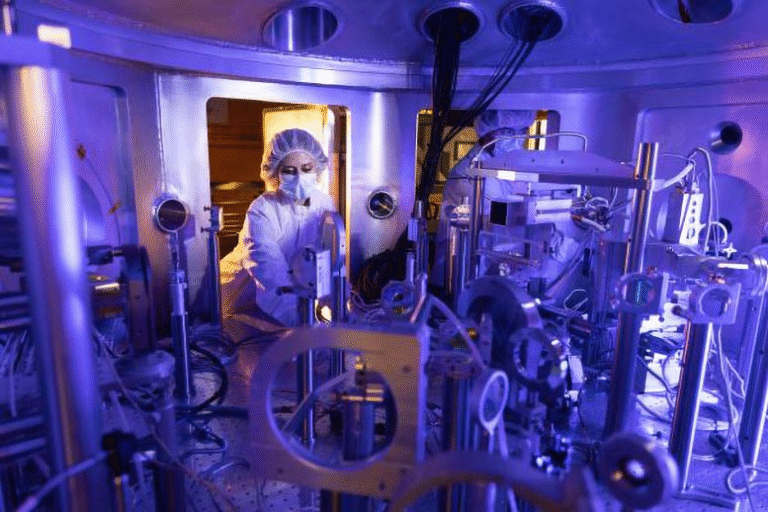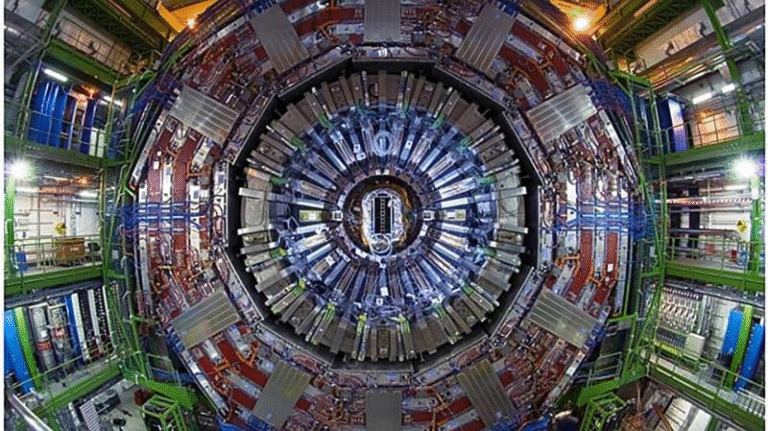Scientists Successfully Date 85-Million-Year-Old Dinosaur Eggs in China
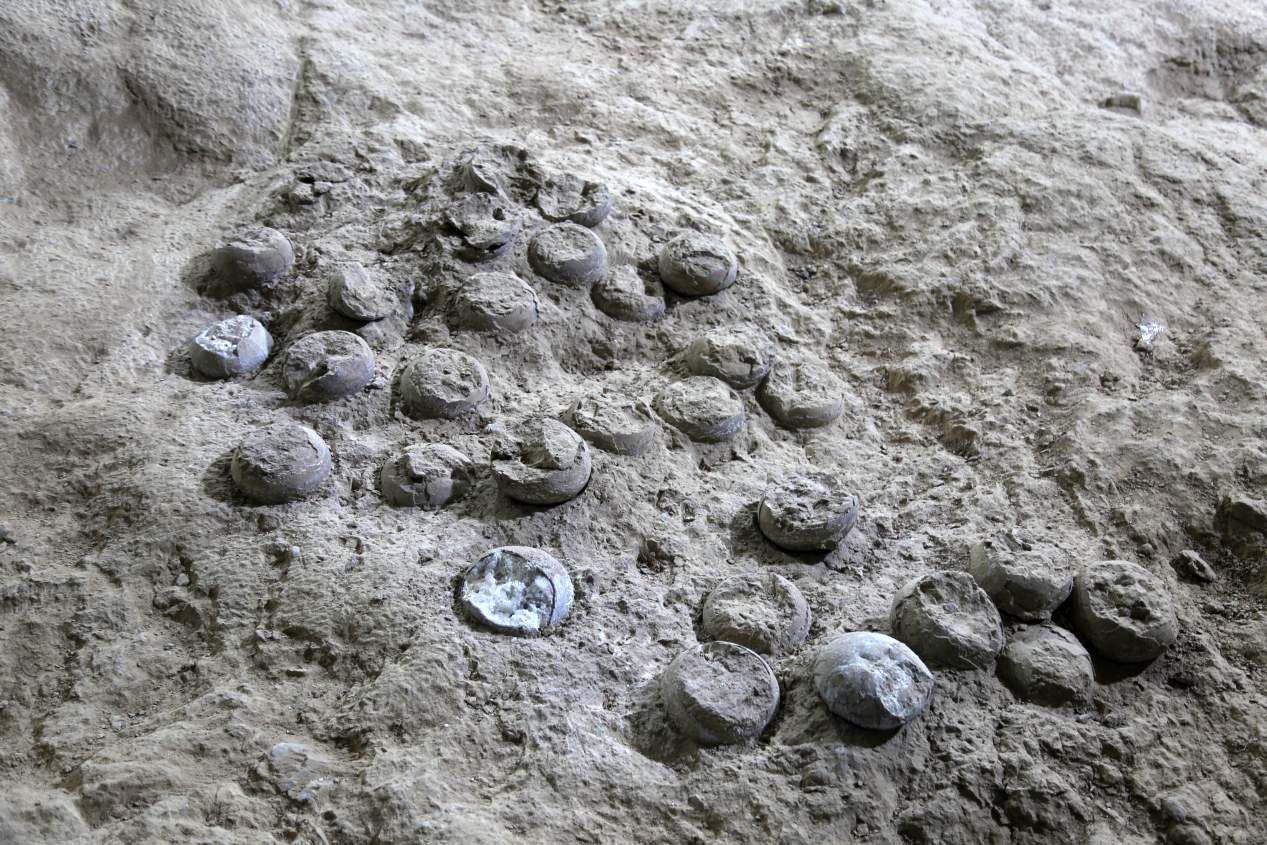
For the first time ever, scientists have directly determined the age of fossilized dinosaur eggs, and the results are remarkable. A team of researchers in China has dated eggs from the Late Cretaceous period to about 85.9 million years ago. This breakthrough not only resolves long-standing uncertainties about when these eggs were laid but also sheds light on climate shifts and evolutionary pressures that dinosaurs faced at the time.
The Qinglongshan Discovery
The eggs come from the Qinglongshan site in the Yunyang Basin of central China, specifically Hubei Province. This site has now been recognized as China’s first national reserve dedicated to dinosaur egg fossils. More than 3,000 eggs have been unearthed there across three separate sites, many of them preserved in their original positions with minimal deformation.
The eggs examined in this study belong primarily to a type called Placoolithus tumiaolingensis, part of the family Dendroolithidae. These eggs are notable because of their highly porous shells, which stand out compared to many other dinosaur eggs. The clutch sampled for this study contained 28 eggs preserved in breccia-rich siltstone, with one calcite-filled egg providing the samples for analysis.
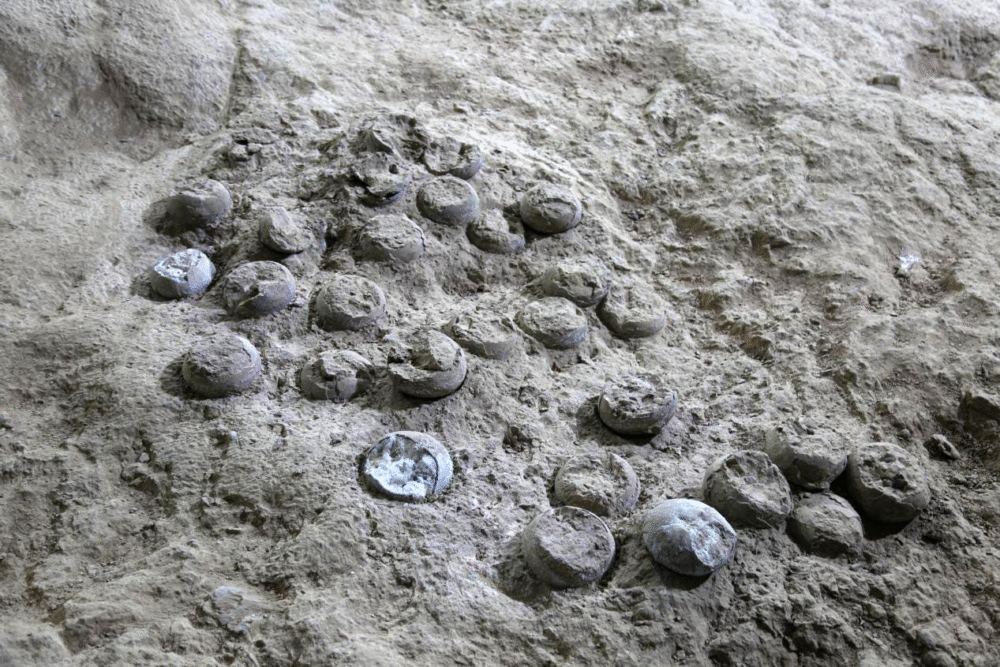
The New Dating Method
Traditionally, scientists have struggled to determine the age of dinosaur eggs with precision. Most previous attempts relied on dating volcanic ash layers, igneous rocks, or surrounding sediments, but those methods are indirect and often inaccurate. The fossil might be older or younger than the materials nearby.
In this new study, researchers used uranium-lead (U-Pb) carbonate dating applied directly to the eggshell carbonate itself. Using laser ablation multi-collector inductively coupled plasma mass spectrometry (LA-MC-ICP-MS), they vaporized tiny fragments of the eggshell’s calcite and measured uranium and lead isotopes. Because uranium decays into lead at a known fixed rate, this acts like an atomic clock for fossils.
The analysis showed that the eggs were deposited 85.91 ± 1.74 million years ago. This places them firmly in the Late Cretaceous, specifically near the boundary between the Coniacian and Santonian stages.
Why This Matters
Direct Dating of Fossils
This is the first successful attempt to date dinosaur eggs directly, eliminating reliance on surrounding geological features. It creates a robust chronological constraint for dinosaur egg fossils, allowing scientists to build more reliable global timelines.
Climate Context
By the time these eggs were laid, the world had already begun to cool. A cooling trend had started earlier, during the Turonian epoch (around 94–90 million years ago), and by the Late Cretaceous, global temperatures were declining significantly.
This climate shift likely played a role in dinosaur diversity decreasing. Cooling may have influenced how many eggs species could lay, as well as where they could thrive. The unusual pore structure of Dendroolithidae eggs is thought to be an adaptation to these environmental changes. However, researchers also believe this adaptation may not have been successful in the long run, and Placoolithus tumiaolingensis may represent an evolutionary dead end.
Geological Significance
Assigning a precise age to the Qinglongshan eggs also helps refine the stratigraphy of the Yunyang Basin. Many Late Cretaceous fossil-bearing sites across China (such as Nanxiong, Xixia, Jiaolai, and Tiantai) depend on less precise methods like biostratigraphy and paleomagnetism. Direct dating provides an anchor point that can improve regional and global comparisons of dinosaur-bearing layers.
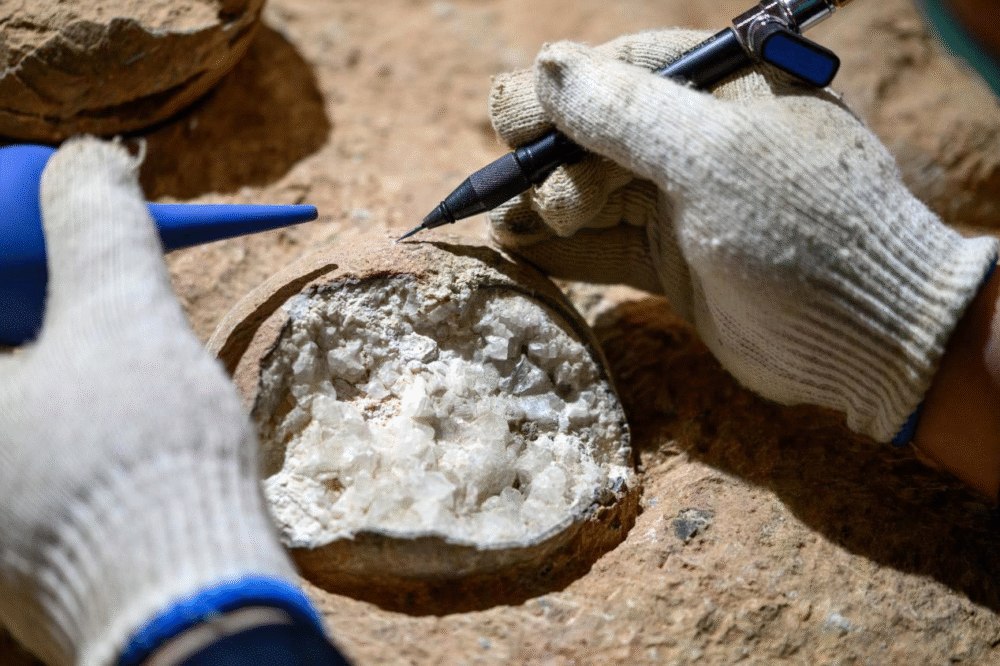
Next Steps in Research
The study tested only a small number of eggshell samples, all consistent in age. Future work will expand to eggs found in different rock layers at Qinglongshan and to similar fossils in nearby basins. Doing so could reveal regional timelines of dinosaur evolution, migration, and extinction.
Researchers also note that while calcite provides a strong uranium-lead signal, scientists must always consider how much of that mineral is original biogenic material versus secondary deposits from fossilization processes. If widely applicable, this method could revolutionize how paleontologists date not just eggs, but other carbonate-bearing fossils.
What Are Dendroolithid Eggs?
The eggs dated in this study belong to the family Dendroolithidae. These eggs are known for their branching pore canals, a feature unlike the simpler pore structures of many other dinosaurs.
This high porosity may have been an adaptation to climatic conditions—helping regulate gas exchange between the embryo and the external environment. However, these specialized traits might also have left them vulnerable if environmental conditions shifted too rapidly.
The species most common at Qinglongshan, Placoolithus tumiaolingensis, is an ootaxon (egg classification, not the actual dinosaur species) recognized by its distinctive shell texture. The actual dinosaur that laid them is not yet known, though eggshell morphology often gives clues about potential parent groups.
Dinosaur Reproduction and Egg Fossils
How Eggs Fossilize
Fossilized dinosaur eggs are relatively rare compared to bones. For eggs to fossilize, they must be buried quickly in sediments that prevent them from being crushed or destroyed. Over time, the original shell material can be replaced or filled with minerals like calcite, as was the case in the Qinglongshan eggs.
Egg Diversity
Dinosaur eggs come in a wide variety of shapes, sizes, and shell structures. Some were elongated, others more spherical. Thickness varied depending on species, with some shells less than a millimeter thick, while others reached several millimeters.
Porosity is another key factor—different pore structures reflect adaptations to incubation strategies, such as whether eggs were buried, exposed, or partially covered by vegetation.
What Eggs Tell Us About Dinosaurs
Studying eggs can reveal crucial information:
- Reproductive strategies: clutch size, egg arrangement, and nesting behavior.
- Environmental adaptation: pore density and shell thickness suggest whether eggs were adapted for humid, arid, or cooling conditions.
- Evolutionary changes: as climates changed, so did egg structures, hinting at which lineages adapted and which did not.
Broader Late Cretaceous Context
The Late Cretaceous (100–66 million years ago) was a dynamic period on Earth. While dinosaurs flourished, the planet experienced major environmental upheavals:
- Intense volcanic activity altered climates and environments.
- Oxygen levels in oceans dropped, causing marine extinctions.
- Gradual cooling reshaped ecosystems before the final extinction event at 66 million years ago.
The Qinglongshan eggs, dated to 85.9 million years ago, fall into this transitional window when global cooling was reducing diversity. This makes them an especially important marker for understanding how climate pressures influenced dinosaur reproduction.
The Significance of This Study
This research demonstrates that dinosaur fossils can be dated directly with great precision. That leap removes much of the guesswork paleontologists previously faced. With this method, egg-bearing layers across the globe could soon be dated more accurately, helping build a global chronology of dinosaur reproduction and extinction patterns.
It also highlights how environmental stressors like climate cooling could have influenced reproductive strategies, pushing some species toward adaptations that ultimately didn’t succeed.
In short, these eggs don’t just represent embryos that never hatched. They represent a snapshot in time—a window into how life on Earth was struggling and changing under shifting conditions 85 million years ago.
